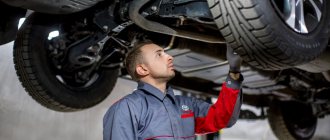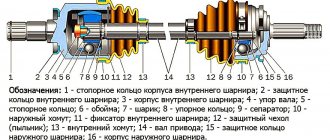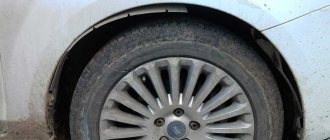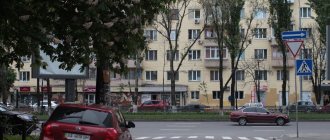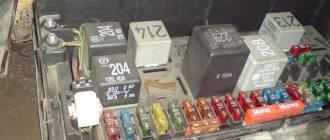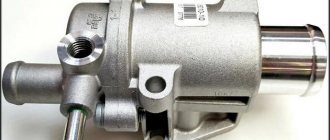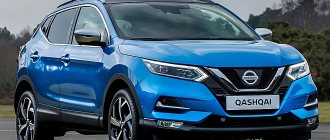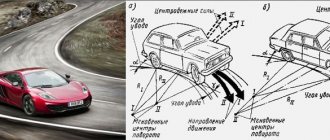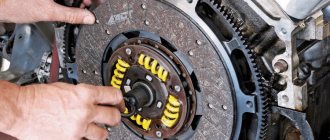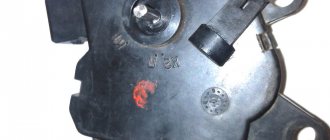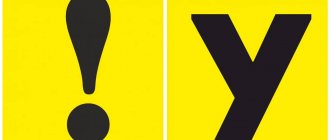Good afternoon, dear reader.
This article will consider mandatory traffic signs , which are the subject of Part 4 of Appendix 1 to the Traffic Regulations. Just like the previously discussed prohibiting road signs, a driver can violate the requirements of mandatory road signs, for which the Code of Administrative Offenses of the Russian Federation of 2022 provides for penalties ranging from small fines to deprivation of a driver’s license.
So, today we will consider the following prescriptive signs: moving straight, moving right, moving left, moving straight or to the right, moving straight or left, moving right or left, going around an obstacle on the right, going around an obstacle on the left, going around an obstacle on the right or left.
List of previously published articles in the “Traffic Signs” series:
- Warning road signs.
- Signs: pedestrian crossing, beware of children, slippery road, speed bump.
- Signs: road works, wild animals, traffic jams, other dangers.
- Priority signs: main road, give way, driving without stopping is prohibited.
- Prohibiting traffic signs: traffic is prohibited, entry is prohibited.
- Signs: pedestrians are prohibited, bicycles are prohibited, and trailers are prohibited.
- Signs for height restrictions, weight restrictions, length restrictions.
- Signs: U-turn prohibited, left turn prohibited, right turn prohibited.
- No overtaking signs, no sound signal, maximum speed limit.
- No parking signs, no parking on odd days of the month, no parking on even days of the month.
Go straight ahead sign
sign requiring allows the driver to move only in the straight direction:
Please note that this sign prohibits traffic in all other directions.
Features of the straight ahead sign:
- If it is installed at an intersection, then its effect applies only to the intersection of roadways in front of which it is installed.
- If a sign is installed outside an intersection, its effect extends to the nearest intersection. However, it is not prohibited to turn right to enter the adjacent territory.
- Route vehicles have the right not to comply with the requirements of this sign.
Please note that a straight ahead sign can be installed, for example, in a gap in the dividing strip, to prevent vehicles from turning left and turning around.
Please note that violating the requirements of this sign may result in your vehicle ending up on a one-way road and moving there in the opposite direction. Naturally, this is quite dangerous, and such a maneuver is punishable by deprivation of rights.
How can the traffic police prove your guilt?
Traffic police officers can detect violations committed by motorists while patrolling the area. If a protocol has already been drawn up regarding your violation, you can avoid punishment only if you find enough arguments to challenge the information contained in it in court.
Reference. To prove the guilt of the offender, traffic police officers can provide photographs taken directly at the scene of the offense or video materials.
Also, many representatives of law enforcement agencies also try to obtain testimony , since with some legal experience, evidence in the form of photographs is easy to challenge.
Any materials that indicate that at a certain time the violator’s car was at the scene of the offense and was directly involved in it will be suitable as evidence.
On our website in this article we talked about the size of fines for violating lane markings when changing lanes in a tunnel or at an intersection, and here you can find out what fines are imposed for driving on the side of the road and why it is prohibited.
Right or left traffic sign
Sign 4.1.6 “Moving right or left” allows you to make a U-turn, turn left and turn right:
The only direction you can't move is straight.
Let's consider the characteristic features of all of the above prescriptive signs (4.1.1 - 4.1.6):
- They apply only to the intersection of roadways in front of which they are installed.
- They do not apply to public transport.
- Signs may use other arrow configurations to suit a specific roadway intersection.
Penalties for violating signs 4.1.1 - 4.1.6 completely depend on which points of the traffic rules will be additionally violated:
1. If the driver simply violates the requirement of a road sign, then he will be fined in the amount of 500 rubles.
For example, when leaving a yard on a two-lane road without markings, a sign “Move to the left” is installed, and the driver turns right.
2. If the driver turns left or makes a U-turn in a place where this is prohibited by one of the above signs, he will be fined 1,000 - 1,500 rubles.
For example, this can happen when making a U-turn at an intersection where there is a “Move to the right” sign.
3. If the driver, having violated the requirements of any of the above signs, ends up in the lane for fixed-route vehicles, then he will be fined 1,500 rubles (3,000 rubles in Moscow and St. Petersburg).
4. If, after violating a road sign, you enter a one-way road, then the driver will either be fined in the amount of 5,000 rubles, or he will be deprived of his driver’s license for a period of 4 to 6 months.
A complete list of fines for violating traffic rules can be found on the traffic police fine table for 2022 page.
What traffic signs allow and prohibit making a U-turn?
3.18.2 “Left turn prohibited”
If the sign is red and crossed out, it means you can’t. A simple rule will help avoid problems. Moreover, only what is crossed out is not allowed, the rest is welcome.
Sign 3.18.2 - “Left turn prohibited”
Prohibits left turns. Allows reversal.
3.19 “U-turn prohibited”
Everything seems to be clear, but, as practice shows, not for everyone. The sign prohibits only turning around, but not turning left! Be careful!
Sign 3.19 - “No U-turn”
Prohibits turning around. Allows left turns.
4.1.1 "Move straight"
4.1.2 "Move to the right"
4.1.5 “Move straight or right”
There are more such signs and they introduce quite a few prohibitions, despite the fact that they are blue and without crossing out. It is recommended to follow only the direction indicated in the picture
Left turns and U-turns are prohibited. They allow movement only straight, only right, straight or right.
4.1.3 “Move left” and 4.1.4 “Move straight and left”
You need to follow the arrow, but if the sign allows you to turn left, then turning around is not prohibited.
Left turns and U-turns are allowed.
5.15.1 “Driving directions along lanes”
We see these signs before intersections, usually from above. They tell the driver which lane is allowed to go where. When the sign shows a turn from the leftmost lane, it does not prohibit a turn, unless, of course, there is a sign prohibiting a turn 3.19.
Such a sign can prohibit left turns and U-turns.
U-Turn Sign
It is designed for reversals. Often there is a passage opposite the turning area (the entrance to a yard or a gas station), and drivers take advantage of this - turning is not prohibited, which means it is possible to turn. Unfortunately, this thesis is incorrect. The traffic rules in this case only allow a U-turn! Remember, you can only do what is shown on the sign, so you will not break any rules.
Allows reversal. Prohibits left turns
Many navigators contain information about maps and installed road signs. If it is on the map in the navigator, but it is not there, do not rush to rejoice. It could have been dismantled or removed, but this does not mean that the entire traffic lane has adapted to the absence of a sign.
In this case, the driver may be given a warning for breaking the rules, but the punishment will be reduced because there is no sign. This situation happens often, because the traffic controller does not always have time to arrive at the site of the dismantled sign.
5.7.1 “Entering a one-way road”
If there is such a sign in front of the intersection, then the street is one-way, you can go straight. The arrow points to the right, which means that if you make a left turn, you will find yourself in oncoming traffic.
Turning is not prohibited, but be careful, there may be a direct restriction somewhere nearby.
Allows straight ahead, right turn and U-turn. Prohibits left turns
Point 7 of Section 8 of the Road Rules of the Republic of Kazakhstan puts everything in its place: the turn (and when making a turn you have to be guided by the same point) must be carried out in such a way that when leaving the intersection of roadways the vehicle does not end up on the side of oncoming traffic. When you turn around at an intersection, you are in the intersection zone, which means there is no violation.
Is it possible to pay a fine online?
In case of real punishment, paying a mandatory traffic fine via the Internet is now also possible and quite simple. The whole procedure will take a few minutes - there is no need to manually enter details or print out a payment receipt. The entire algorithm includes the following list of documents:
- Driver's license.
- Car registration certificate.
- Resolution imposing a fine.
You can even transfer funds online using bank cards of any Russian banks (Visa, Mastercard and even Mir).
Directly on the State Services portal, you can independently check and pay fines for traffic violations, including turning right. This is where the most complete information about such incidents is collected. You only need to indicate in the search form the number of your license and vehicle registration number in order to receive data on fines imposed by the traffic police and for incorrect parking.
Prohibiting varieties
Outwardly, it is very simple to distinguish them - a circle with a red border on a white or blue background, which is quite difficult not to notice. This is a very large group that regulates literally all aspects of road traffic, starting from the maximum permissible speed, restrictions on the weight and types of vehicles, and ending with the ban on entry, parking and stopping of cars on various sections of the road.
It is important not only to confidently imagine what prohibitory signs look like and what exactly they prohibit, but also to understand exactly on which sections of the roadway they operate, that is, to imagine the area of effect of the sign. Let's first figure out where the zone of action of the prohibiting species begins.
Regarding the lanes to which it applies, everything is also quite simple - prohibitory signs only apply to one side of the road, where they are installed.
Of course, there are exceptions to any rule. So, for example, the “Parking is prohibited” type, established at the entrance to the yard, does not apply to persons living in the house or working in an organization located here, if a detour is not provided. There are other exceptions related to the action of this sign, which will be discussed below.
Sign No parking
This road symbol can be found very often - a blue circle with a red border, crossed diagonally by one red stripe. It is clear that it prohibits parking of vehicles on any day of the week.
But sometimes you can find it prohibiting parking, for example, only on odd days, or even days - on them one or two white stripes (vertical) are drawn inside a crossed out circle. Accordingly, one lane is crossed out - you cannot park a car only on odd days, two - on even days.
However, there are restrictions here too - the ban is valid only until the evening - until 19.00, so in order not to break the rules, before 21.00 the vehicle must be driven to the other side of the road - as a rule, a sign with a reverse restriction is installed on it.
Well, in the period from 19.00 to 21.00 you can park your car in the coverage area of any sign - you will not break the rules. It should also be noted that there are categories of people who can safely ignore the “Parking Prohibited” symbol.
We will not describe in detail the rules for federal postal vehicles, for which this type does not apply - this is not relevant for us. It is much more important that cars of disabled people of groups I and II and persons transporting such disabled people can park under this graphic element without fear.
No parking or stopping sign
This type, so to speak, is closely related to the road sign we described above. The fact is that where stopping is prohibited, parking is also prohibited, but not vice versa.
You can stop in a “No Parking” zone and you won’t be fined. Let's take a brief look at how a parking lot differs from a stop.
There are no difficulties here, since this issue is covered in some detail in the traffic rules. Understanding the differences between parking and stopping is very simple.
But if at the same time you perform actions related to boarding/disembarking passengers, loading/unloading a car, then regardless of how much time it takes you, you will make a stop, not a parking lot, even if it lasts at least 15 minutes, at least a whole hour.
Externally, “Parking and stopping is prohibited” is very similar to the prohibitory type we described above, only it is no longer one diagonal red stripe on a blue background, but two intersecting stripes.
Read also: Checking the Toyota Corolla ignition coil
It also applies only to its own lane. Exceptions to which this symbol does not apply include only route vehicles. Please note that disabled people in their vehicles can no longer stop in the coverage area of this element, unless, of course, a corresponding information sign is installed under it.
Area of operation of the “No parking” sign
In general, its coverage area is the same as that of other prohibitory images, that is, from the installation site to the first intersection, or to the end of the populated area, if no other symbols are installed that remove the restriction.
However, there are nuances:
- Firstly, the zone can be defined by a yellow broken marking line at the edge of the roadway: as long as it is there, parking is prohibited, and with the end of this line, the sign’s coverage area ends.
- Secondly, at the beginning of the article it was not for nothing that we briefly mentioned other road types, in particular, signs used in conjunction with other types to clarify the action of the latter.
Thus, the coverage area signs (vertical arrows on a white rectangle), located under the sign, precisely determine its coverage area.
Thus, if under the graphic element “Parking Prohibited” you see an arrow pointing down, this means the end of the sign’s coverage area - it will be possible to leave a vehicle behind it, unless, of course, other traffic rules are violated. If the sign indicates an arrow pointing upward, this means that the coverage area will begin from the location where the sign is installed, but you can also usually see a number indicating the length of the coverage area in meters.
The direction of movement to which the sign applies is also important. A regular blue circle crossed out with a red stripe, like any other prohibiting type, only applies to the side of the road where it is installed. At the same time, remember also about the “Parking Restricted Zone” view, which is a large white rectangle with a “No Parking” sign drawn inside it - it already applies to the entire roadway.
The parking ban is also canceled by the “End of all restrictions zone” pictogram - a white circle with black stripes crossing it out. By the way, there is a similar sign for the above-mentioned “Parking Restriction Zone”.
Penalty for parking a vehicle in a “No Parking” zone
The Code of Administrative Offenses states that ignoring requirements of this type provides for a fine of 1,500 rubles. And if the offense was committed in Moscow or St. Petersburg, then the fine will already amount to 3,000 rubles.
In addition, the car can easily be sent to a penalty area. In order to receive a fine for illegal stopping or parking, by the way, it is not at all necessary to stop in the area covered by the relevant signs.
If you happen to, for example, leave your car closer than five meters to a pedestrian crossing or on it itself, then you will be given the same fines.
Compatibility with other types
We mentioned above that “No parking” can be installed in conjunction with information signs.
They are divided into a couple of groups:
- Indicating the type of vehicle for which parking is prohibited. These can be motorcycles, trucks, trucks with trailers, route vehicles, etc.
- Coverage area signs. These are vertical arrows on a white background that can point up, down, or both ways. They indicate the direction of the zone in which the sign is valid. Sometimes the sign additionally indicates the distance of the coverage area in meters.
To protect yourself from monetary losses caused by exorbitant fines and costs of “rescuing” a car from a parking lot, do not neglect the parking rules determined by the corresponding information symbols on the road, markings, etc.
After all, failure to comply with these requirements can cause accidents on the road, numerous casualties, and simply create traffic jams that get on your nerves when driving through a densely populated city. Therefore, do not break the rules, leave your car in the parking lot only in permitted places.
When driving a vehicle, it is imperative to know the prescribed traffic rules and follow them. To make it easier for drivers to navigate one-way roads, 5.5 traffic control signs will be installed everywhere in 2022.
If you know all their symbols and strictly follow them, there will be no confusion on the road.
How much does a violation cost?
The amount of punishment for committing actions that violate traffic rules in the part that is regulated by the graphic elements described above cannot be immediately determined. It is necessary to understand the nature of the violation, then it will be clear what fine the violator faces.
- If the requirements established by the road sign are violated, the driver will be fined in the amount of 500 rubles. A clear example of such a violation is a situation in which a car drives out of a yard onto an unmarked road with two lanes and turns left, although the sign only allows right turns.
- Making a turn in the opposite direction, which contradicts the rule depicted by the road safety element, will entail a penalty of 1 thousand to 1.5 thousand rubles. For example, you can take the situation at an intersection with a “Move to the right” sign when the driver makes a U-turn. In case of these illegal actions, you will have to pay a fine, and it is better not to perform such maneuvers in the future.
- If you violate the rules of one of the signs discussed above, the driver may find himself in the lane intended for the movement of route vehicles. In this case, you will have to pay a fine of 1.5 thousand rubles. And if such a violation occurs in Moscow or St. Petersburg, the fine will double.
- The largest penalty is provided for turning and moving along a one-way lane for movement - 5 thousand rubles. Not only will you have to pay a fine, but you can also lose your license for up to six months.
In a word, it is better not to violate traffic rules. It will be better for your budget and safer for the people around you.
In fact, there is nothing difficult in following these simple rules, which make the movement of vehicles and the movement of pedestrians orderly and safe. If each participant follows these rules and follows the corresponding signs, there will be fewer accidents, and moving along the streets of our cities will become safer.
List of suitable markup elements
- The “Go straight ahead” sign is a prescriptive sign and has the shape of a blue circle with a white arrow in the center. It gives the car owner permission to drive only straight and not turn anywhere. To some extent, this designation is prohibitive, since if it is present, the driver is prohibited from moving in another direction - only straight ahead. This road sign can be installed along with a configuration of arrows that correspond to all the necessary directions that exist at a particular intersection.
This marking element has a number of features that depend on the location of its installation:
- the presence of such an element at an intersection limits its effect only on those roadways to which it belongs;
- When this marking element is located outside the intersection, its effect continues only to the nearest road intersection. In this case, the vehicle is allowed to enter the adjacent territories;
- The installation of a sign can be carried out in places where the dividing strip breaks to establish a ban on cars turning to the left or making a U-turn;
- This sign does not apply to route vehicles.
If you violate these rules, you can not only run into a fine, but also make a turn onto a road on which you can only travel in one direction. And this can already lead to more serious consequences in the form of an accident and deprivation of rights.
- The Right Turn sign is also a mandatory safety graphic and is shaped like a blue circle with a white arrow in the center indicating a right turn. This prescriptive designation allows the vehicle to travel exclusively in the direction that corresponds to the arrow on the sign. It has prohibitive characteristics, because if this sign is present, the driver is prohibited from driving straight, turning left and making a U-turn. This prescriptive road element can often be seen at the exit from parking areas, gas stations, and on roads with a large number of lanes (4 or more). Its action continues until the first intersection.
- The “Move straight and right” sign looks like a blue circle containing an arrow with a forked end. One part of the arrow points straight ahead, and the other part points to the right. This means that travel can continue in any of those directions indicated by the prescriptive road safety element. Turning in the opposite direction or performing a U-turn maneuver is strictly prohibited. The sign continues until the first intersection, after which you can make any maneuver in the absence of other prohibiting or prescriptive signs.
- The sign “Avoid obstacles on the right” indicates that if there is an obstacle ahead, you must turn right. Obstacles may be temporary or in the form of islands of safety. A similar designation with two oblique arrows allows turning both right and left, but not straight.
Are you required to turn on your turn signals in this situation?
| 1. | ? | Yes, but only if there are other vehicles at the intersection. |
| 2. | ? | Yes. |
| 3. | ? | No. |
At this intersection, following the “Move to the right” sign, you can continue moving only to the right. In this case, you must turn on the right turn signal lights corresponding to this maneuver.
Warning
Warning signs are triangular in shape, white with a red edge. The only exceptions to this rule are signs indicating railroad crossings and turning directions.
The requirements of warning signs cannot be violated because they do not prohibit anything. The purpose of these signs is to warn the driver of approaching danger. For example, about the narrowing of the road ahead, the possibility of animals entering the road, slippery roads and dangerous turns.
Such signs are installed 50-300 m from the danger, depending on where it is located - in the city or on the highway.
Also read: Is it possible to get a license without attending a driving school?
